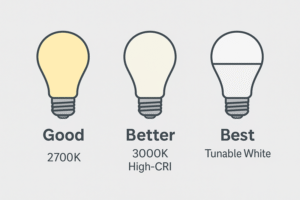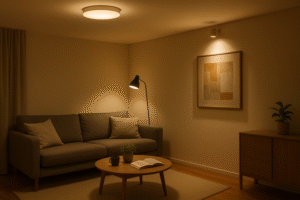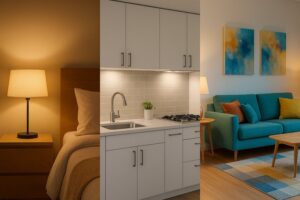You've invested in a prime commercial location and quality inventory, but the space feels lifeless. Employee productivity is lagging, and customer engagement just isn't translating into sales, leaving you questioning your investment.
Strategic LED lighting is an active business asset that enhances productivity, provides a measurable return on investment, and adapts to your needs. It transforms your physical space from a simple cost into a hard-working tool for growth.
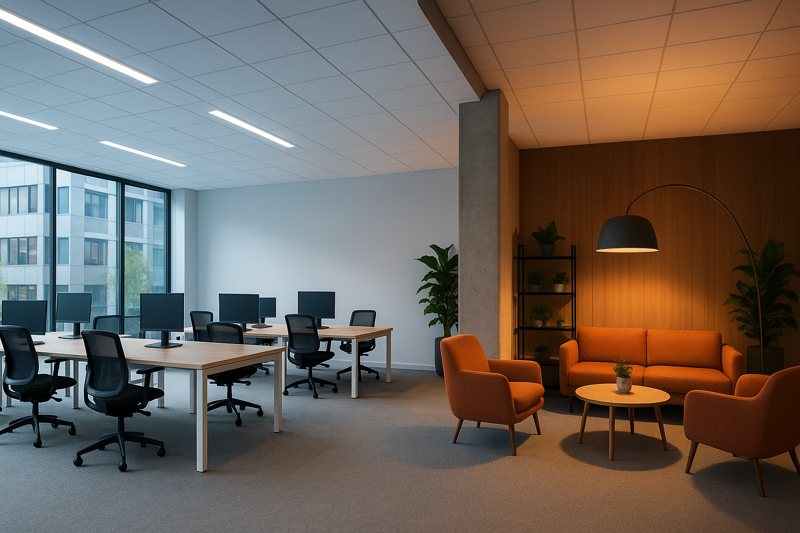
I remember talking to a facilities manager for a US-based company with a large office and warehouse. He was tasked with cutting operational costs, and his first thought was to find the absolute cheapest G9 bulbs for their thousands of fixtures. He saw lighting as a pure expense. I asked him to consider the other costs: employee errors in the warehouse due to poor visibility, and afternoon slumps in the office under harsh fluorescent light. We ran the numbers on a strategic upgrade to high-CRI, flicker-free LEDs with appropriate color temperatures for different zones. The value proposition shifted from "How much can we save on the bulb?" to "How much can we gain in productivity and reduce in errors?" He became a long-term client.
How Can Your Lighting Improve Employee Productivity and Well-being?
Your office staff seems tired by midday, and you're noticing picking errors in the warehouse. You blame it on the post-lunch slump, but the issue is consistent, hurting efficiency and morale.
By implementing Human-Centric Lighting (HCL), you can use different light colors and qualities to support the body's natural rhythms. Cool, bright light boosts alertness for focused tasks, while warmer light promotes relaxation in break areas.
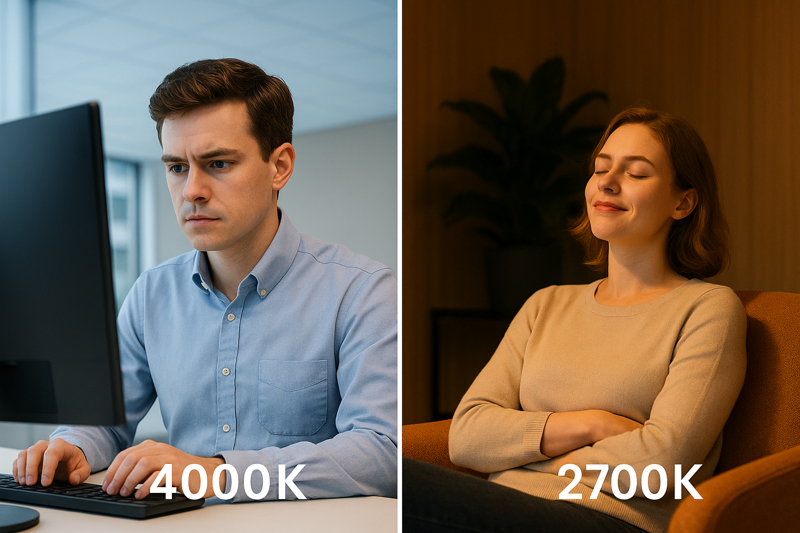
This is one of the most exciting frontiers in commercial lighting, moving beyond simple illumination to actively support human biology. Our bodies are tuned to the daily cycle of sunlight. Strategic lighting design mimics this cycle indoors to create better work environments. For focused work areas like office desks or warehouse packing stations, using a cooler color temperature (4000K-5000K) replicates the midday sun, signaling our brains to be alert and attentive. This has been shown to reduce errors and improve concentration. Conversely, in break rooms and cafeterias, shifting to a warmer tone (2700K-3000K) helps employees to properly relax and recharge. It's not just about color; quality is critical. Our flicker-free Omita LEDs prevent the subconscious eye strain and headaches associated with cheaper alternatives, further reducing fatigue. For a business owner, this isn't a frivolous expense; it's a direct investment in your most valuable asset: your people.
The Science of Circadian Rhythm
Our internal body clock, the circadian rhythm, is primarily regulated by light exposure. Blue-rich, cool light suppresses the production of melatonin (the sleep hormone) and boosts alertness. As a business owner or manager, you can leverage this by installing tunable lighting systems1 or simply zoning your space with the right fixed-color temperature bulbs for the task at hand.
Lighting Quality and Detailed Tasks
Beyond color temperature, high Color Rendering Index (CRI)2 is essential for any task requiring accuracy. In a warehouse, a high-CRI light helps workers distinguish between subtle differences in product labels, reducing picking errors. In a design office, it ensures that the colors on screen match the colors on a printed proof. Investing in 90+ CRI bulbs is a simple way to improve quality control across the board.
Zone-Based Lighting for Optimal Performance
| Zone Type | Recommended Kelvin | Primary Goal | Omita Product Solution |
|---|---|---|---|
| Focused Workstations | 4000K - 5000K | Maximize alertness, improve accuracy | High-CRI G9 Bulbs, LED Panels |
| Collaborative Areas | 3500K - 4000K | Encourage communication, friendly feel | Dimmable Downlights |
| Break Rooms / Lounges | 2700K - 3000K | Promote relaxation and rest | LED Filament Bulbs (A60, ST64) |
| Warehouses / Task Areas | 5000K | High visibility, safety, error reduction | High-Bay LED Fixtures |
Is Your Lighting System a Financial Asset or Just a Sunk Cost?
You look at your company's P&L statement and see electricity and maintenance as major, unavoidable costs. You delay lighting upgrades because you only see the upfront expense, not the long-term financial gain.
A strategic LED upgrade is an investment with a rapid and measurable Return on Investment (ROI). The savings from drastically reduced energy consumption and near-zero maintenance costs often pay for the entire project within 1-3 years.
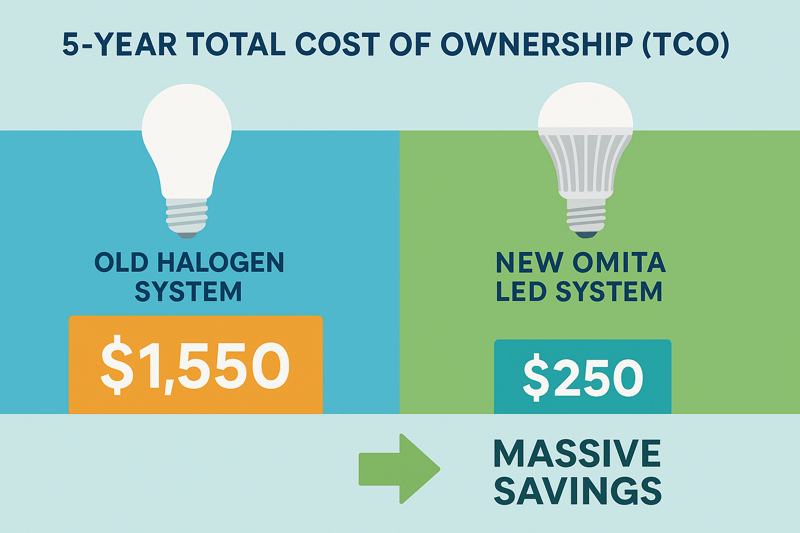
For any practical buyer like my customer Jacky, the numbers have to make sense. The sticker price of a high-quality LED bulb is higher than an old halogen, and it's easy to stop the calculation there. But that’s a mistake. The true cost is the Total Cost of Ownership (TCO). LED technology is up to 80% more efficient than legacy lighting. That means for every $100 you were spending on electricity to run old lights, you could be spending as little as $20 with LEDs. Furthermore, our Omita LEDs have lifespans of 25,000 to 50,000 hours. Compare that to a halogen bulb's 2,000 hours. This means you are not just saving on energy; you are saving on the cost of replacement bulbs and, more importantly, the labor cost of constantly having maintenance staff climb ladders to swap them out. When you present the full picture, the decision becomes simple. The initial investment is quickly recovered, and after the payback period, the savings drop directly to your business's bottom line every single month.
Calculating Your Energy Savings
The math is straightforward. Find the wattage of your current bulbs and the wattage of the proposed LED replacement. The difference is your per-bulb energy reduction3. Multiply that by the number of fixtures and hours of operation, and the savings become substantial. A single 50W halogen spotlight replaced by a 7W Omita LED spotlight running 10 hours a day saves over 150 kWh per year. Across an entire store, that's a huge operational win.
The Hidden Cost of Maintenance
Maintenance is a significant hidden expense. For a retail store with 100 spotlights, if 10% of old halogens fail each year, that's 10 service calls. That requires staff time, disruption to the sales floor, and the cost of replacement bulbs. With a high-quality LED system, you might have zero failures in the first 5 years. This reliability is a core part of the value we build into our products.
Driving Revenue Through Better Lighting
The ROI isn't just about savings; it's about earnings. As discussed in other articles, strategic lighting with high CRI4 and good layering has been proven to increase sales. Better-lit products sell more. Customers who feel more comfortable stay longer and spend more. While harder to quantify than energy savings, this "revenue" side of the ROI is often the most impactful.
Can Your Commercial Space Adapt to Any Mood or Season?
Your retail space has one look, and it stays that way all year. You rely on decorations alone to create a festive mood for holidays or a sense of urgency for a sale, but the underlying atmosphere remains static.
Yes, with dynamic lighting systems, a single space can transform instantly. Tunable white technology allows you to change light from cool to warm, and smart controls let you adjust brightness to create entirely new atmospheres on command.
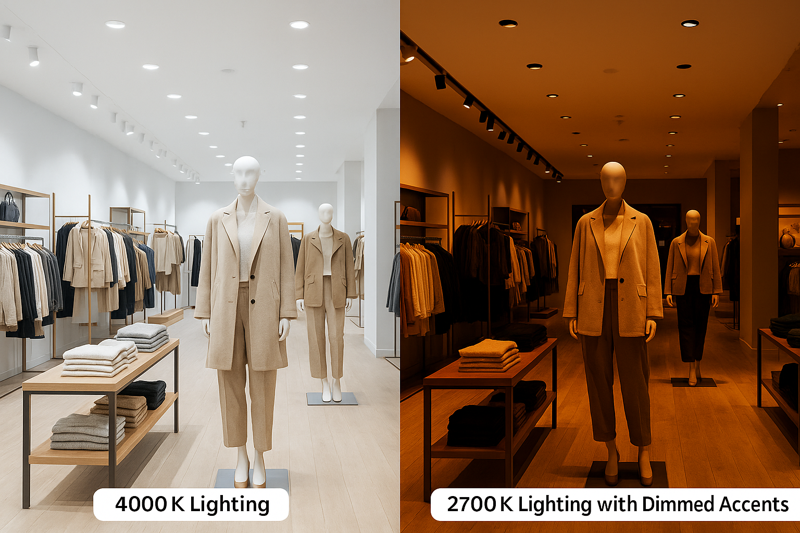
This is where modern lighting moves from a static utility to a flexible marketing tool. Imagine it's a normal Tuesday afternoon; you might want your store to be lit with bright, clean 4000K light to feel energetic and spacious. But now imagine it's the week before Christmas. With a tunable white system, you can press a button and shift the entire store's lighting to a warm, cozy 2700K glow, instantly creating a festive, welcoming atmosphere that encourages lingering and holiday spending. The same space can be adapted for a high-energy product launch or a calm, exclusive VIP evening. As a manufacturer, we are seeing increasing demand for these smart systems. They allow our B2B clients to offer their customers a level of flexibility and customization that was previously impossible. It future-proofs their commercial space, ensuring it can adapt to any trend, season, or event without expensive renovations.
What is Tunable White5?
Tunable white is a feature that allows you to adjust the color temperature (Kelvin) of a white light source. Most systems provide a range from a very warm amber (2200K) to a very cool white (5000K or more), all from the same fixture. This is typically controlled via a wall panel, remote control, or smartphone app.
Practical Applications for Dynamic Lighting
- Retail: Shift from general shopping light to promotional or seasonal moods. Highlight a "summer sale" with bright, cool light and a "winter collection" with warm, cozy light.
- Restaurants: Transition seamlessly from a bright, airy lunch setting to a dim, intimate dinner atmosphere to maximize table turnover and customer experience.
- Hotels: Lobby lighting can be programmed to follow the sun, offering a bright welcome in the morning and a relaxing haven in the evening.
- Offices: Meeting rooms can be tuned to an alert 4000K for brainstorming sessions and a calmer 3000K for general discussions.
Simple Implementation with Smart Bulbs
Full-scale tunable systems can be complex, but this strategy can also be implemented on a smaller scale. Using smart LED filament bulbs in key lamps and fixtures can provide that touch of warmth and adaptability for a specific section or display, offering a taste of dynamic lighting6 without overhauling the entire system.
Are You Using Light to Make Customers Feel Secure and Spend More?
Customers seem hesitant to explore the corners of your store, and fitting rooms are often left empty. The space feels technically bright, but something about it makes people feel exposed or uncomfortable.
Strategic lighting creates psychological comfort and security that encourages longer visits and higher spending. This involves eliminating harsh glare, softening shadows, and using vertical brightness to make a space feel more open and welcoming.
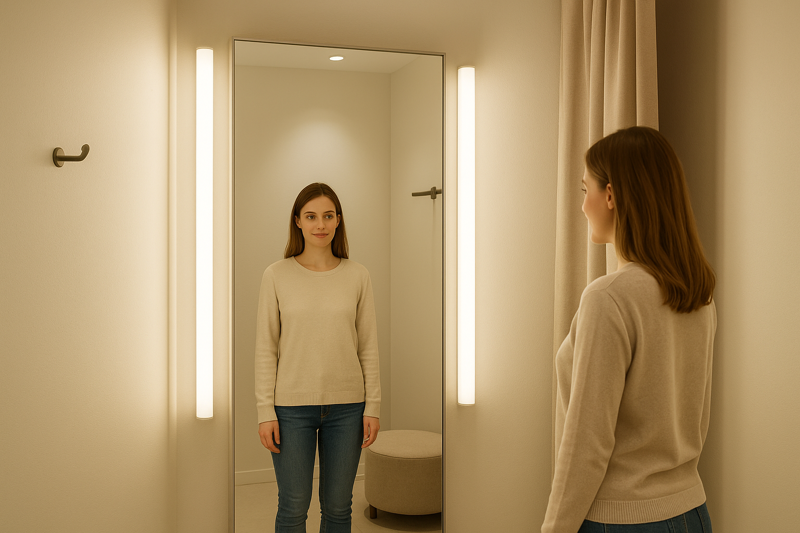
We've talked about guiding the eye and making products look good, but there's a deeper psychological layer. People will not stay in a space that makes them feel uncomfortable. One of the biggest culprits is harsh, top-down lighting, often called "cave effect." It creates sharp shadows on people's faces and makes the walls of a space feel dark and enclosing, even if the floor is bright. The solution is to focus on "vertical illuminance"—lighting the walls and vertical surfaces. When the walls are lit, the entire space feels brighter, larger, and safer. Another critical area is the fitting room. A single overhead downlight is the worst possible choice, as it creates unflattering shadows. The best practice is to use vertical fixtures on either side of the mirror with high-CRI, warm-to-neutral bulbs. When a customer feels good about how they look, they are infinitely more likely to buy. It's a small detail that has a massive impact on sales.
The Principle of Vertical Illuminance1
Instead of just pointing lights down at the floor, aim some of your accent lighting at the walls, displays, and architectural features. Techniques like wall washing (for an even glow) or wall grazing (to highlight texture) can completely transform the perceived size and safety of a room. This simple shift in focus from the horizontal to the vertical plane is a sign of sophisticated lighting design.
Eliminating Glare for Comfort
Glare is light that shines directly into a customer's eyes, causing discomfort and distraction. This is a common problem with cheap, poorly designed spotlights. As a quality-focused manufacturer, we ensure our fixtures are designed to control the light beam. Using baffled downlights, honeycomb louvers, or simply aiming track lights carefully ensures the customer sees the effect of the light, not the distracting source.
The Critical Role of the Fitting Room
The fitting room is often where the final purchase decision is made. It's the most emotionally important part of the retail lighting journey.
- Light Placement: Always use light from the sides of the mirror, not directly overhead.
- Color Temperature: 2700K to 3000K is ideal. It's warm and flattering to skin tones.
- Color Rendering (CRI)2: A CRI of 90+ is mandatory. The customer must see the true color of the garment.
Investing in high-quality lighting for your fitting rooms is investing directly in your closing ratio.
Conclusion
Strategic lighting is an active partner in your business's success. It drives productivity, delivers financial ROI, offers powerful flexibility, and creates a secure environment that encourages customers to spend more.
-
Tunable lighting systems can significantly enhance alertness and comfort, leading to better performance in work environments. ↩ ↩
-
Understanding CRI is crucial for ensuring accurate color representation in various tasks, enhancing quality control. ↩ ↩
-
Understanding energy reduction can help you maximize savings and efficiency in your lighting choices. ↩
-
Exploring high CRI can enhance your knowledge of effective lighting strategies that boost sales and customer satisfaction. ↩
-
Explore this link to understand the science behind Tunable White lighting and its benefits for various environments. ↩
-
Discover how dynamic lighting can enhance ambiance and functionality in spaces like retail, restaurants, and offices. ↩



